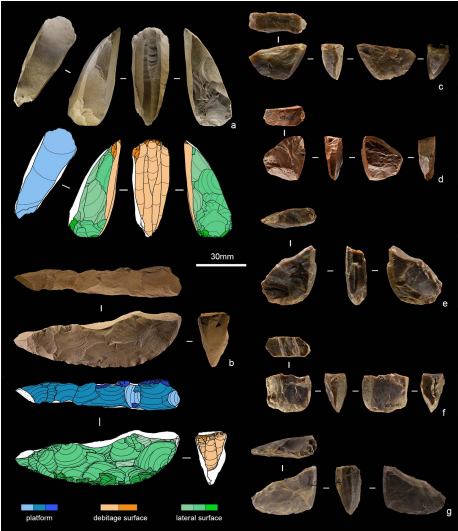The onset of the Neolithic is generally assumed to coincide with the appearance of pottery in northeastern Asia, with some of the earliest pottery appearing in the Amur, or Heilongjiang, River Basin. Two distinct ceramic-producing cultures appeared in the lower Amur River Basin during the Late Glacial, the Osipovka and the Gromatukha, both of which are thought to have emerged as nomadic bands of hunter gatherers began to settle down in the region. The southernmost site associated with the Osipovka Culture is at Xiaonanshan Hill on the west bank of the Ussuri River, a large tributary of the lower Amur.
In a paper published in the journal Antiquity on 13 December 2023, Jian-Ping Yue of the School of History at Anhui University, and the Institute of Vertebrate Paleontology and Paleoanthropology of the Chinese Academy of Sciences, You-Qian Li of the Heilongjiang Provincial Institute of Cultural Relics and Archaeology, Xia-Jun Yan of the Shaanxi Archaeological Museum, Xue-Ya Du, also of the School of History at Anhui University, and Shi-Xia Yang, also of the Institute of Vertebrate Paleontology and Paleoanthropology of the Chinese Academy of Sciences, and of the Australian Research Centre for Human Evolution at Griffith University, describe a new site on the northern slope of the Xiaonanshan Hill, and report on the lithic tools and dating evidence uncovered there.
Xiaonanshan Hill is located on the west bank of the Ussuri River in Raohe County, Heilongjiang Province, which is the most northeasterly province of China. The first archaeological remains were found on the hill in 1958, with sporadic excavations being caried out in the 1970s, 80s, and 90s. Since 2015 the site has been subjected to more systematic archaeological exploration, with five distinct phases of occupation identidified, ranging from about 16 000 years ago to about 2000 years ago.
The Redianchang area on the northern flank of Xiaonanshan Hill was explored in 2021, with eight squares, covering a total area of 130 m². Four distinct stratigraphic units were identified, labelled 1-4, with Layer 1 being the uppermost and Layer 4 the lowest. The site was excavated in 50 mm increments, with the location of lithic artefacts larger than 10 mm being recorded. A total of 16 484 such lithic artefacts were recovered, more than 77% of them from Layer 3. This layer also yielded a piece of charcoal, from which a radiocarbon date of 16 785–16 390 years before the present was obtained.
The majority of the stone tools from Redianchang are made from volcanic tuff, a type of rock readily available in nearby riverbeds, with small amounts of basalt, agate and obsidian also used. Tools were made by microblade, blade and core-flake debitage (flaking) with microblade debitage being the most common type. These had been shaped using the 'Yubetsu technique', which has been recorded at End Pleistocene sites across northeast Asia from Mongolia to Kamchatka, as well as in Japan (where it was first identified). In this technique pebbles or other pieces of rocks were shaped bifacially by the removal of longitudinal spalls to create a platform. Other microblades were made by successive transverse removals to form a platform. Both techniques involved the use of pressure knapping. Simple core-flake and blade reduction are also present.
Two hundred formal tools were identified; scrapers, endscrapers, points, borers, notches and denticulates together made up 58% of this material. Most of these were made using flakes as blanks for the creation of the new tools, but there was little morphological standardisation. Bifacial points make up 15% of the total, these showing a high degree of symmetry achieved through careful shaping. Microblades, made by shaping the end to form a fine tip, make up 18.5% of the total, and adzes another 8%, some of which had been shaped by grinding. A single stone sinker (stone with a carved groove, believed to have been used as a fishing weight) was identified.
The Redianchang assemblage is dominated by microblade debitage tools, made using the Yubetsu techniques, as well as scrapers, bifacial points, retouched microblades and chipped/polished adzes. Similar assemblages were found at other locations on Xiaonanshan during excavations in 2019 and 2020, along with early ceramics, hearths and dwellings. The ceramics comprised low-temperature pottery sherds, often with grass imprints on both sides. Two semi-subterranean dwellings were found, one of which had a central hearth. Radiocarbon dates from these sites yielded dates of between 16 500 and 13 500 years before present, consistent with Xiaonanshan Phase 1. Artefacts show similarities to material from the middle and lower Amur River Basin, including the Gromatukha site, which gives its name to the Gromatukha Culture, and the Gasya, Khummi and Goncharka-1 sites, all of which are associated with the Osipovka Culture.
The combination of technologies seen at Xiaonanshan, including stone-grinding, early pottery, and semi-subterranean dwellings, are consistent with a Late Glacial hunter gatherer population that was starting to settle into a less nomadic lifestyle, and developing new technologies which made better use of locally available resources. This suite of technologies mark the beginning of the Neolithic in the Amur Basin of northeast Asia.
See also...













